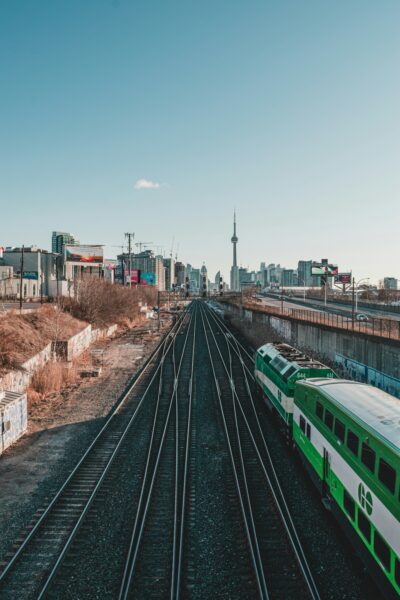
Since starting this job, I have been truly amazed at Brampton’s potential. The excitement is palpable with several key developments on the horizon. We’re soon welcoming a new medical school from TMU. The beginning of 2024 also saw a significant milestone for the LRT project. And the surge in new housing developments will drive densification and necessary economic growth. The recent growth in businesses and business investment is recent evidence of Brampton’s momentum.
Perhaps the greatest success story in Canadian public transit today is the example of Brampton. Brampton Transit ridership saw over 40 million passengers in 2023. With about 3.4 million monthly passengers, Brampton Transit ridership has not only returned to pre-covid figures but has almost doubled it. There is a similar story with The Kitchener GO train as well. The Kitchener GO line also saw a 40% increase in ridership from April to December 2019, and now regularly experiences high ridership levels, even late into the evenings.
Traffic congestion in Brampton continues to worsen, underscoring the urgent need for both public transit and road infrastructure improvements. As the second fastest-growing large city in Canada, Brampton’s road infrastructure has not kept pace with demand. While the Ford government’s Highway 413 aims to address this issue, there is a paradox in fighting congestion with more roads. Studies suggest that improved roads lead to increased traffic, a phenomenon known as “induced demand.”
Research is mixed on whether public transit reduces traffic congestion due to similar induced demand effects. However, the primary goal of investing in public transit should not be solely to reduce congestion but to foster a culture that embraces transit use. Transitioning away from vehicle dependency in Toronto’s suburbs is challenging, but Brampton’s young residents, many of whom do not own cars, make the city ideally suited for this cultural shift. High transit ridership among these residents already indicates a readiness to embrace public transit.
According to Metrolinx projections, investing in two-way, all-day GO train service will attract 10.9 million annual riders by 2041, reduce journey times by up to 20 minutes, and generate over $1.3 billion in economic benefits. Increased service frequency will significantly change ridership behavior. Currently, GO train and bus users plan their trips around GO schedules, with many opting to drive to avoid long waits.
Shorter headway, or wait times between trains, changes this decision-making calculus. If passengers can rely on a train arriving every 15 minutes or less, transit becomes more appealing. This predictability simplifies transit connectivity, reducing the need to coordinate with multiple schedules. The goal of 15 minute headway is not far-fetched either, with Lakeshore West and East now experiencing 15 minute headway on weekend afternoons and evenings.
Think of it like the TTC subway service—few people check the schedule because trains arrive every few minutes. With proper infrastructure investments, interregional transit can achieve similar convenience. The Toronto Region Board of Trade has already proposed a vision for “subway-like” regional transit in their report “Getting on the Right Track: Connecting Communities with Regional Rail.”
The recent announcement of 30-minute service from Bramalea to Union Station – a 43 per cent increase in trips – is a critical step towards achieving two-way, all-day GO service on the Kitchener line. However, this cannot be fully realized until additional dedicated tracks are constructed west of Bramalea GO and key grade separations are implemented where freight and passenger rail crossings intersect. That being said, key infrastructure improvements are already planned by Metrolinx and the City of Brampton.
Demand is not just between Brampton and Toronto, however. The Hazel McCallion LRT will also significantly enhance connectivity between Brampton and Mississauga. Extending into downtown Brampton, this project represents a major victory for those disheartened by council’s 2015 decision. With fare integration implemented earlier this year, the provincial government is clearly prioritizing interregional transit. The new LRT line is projected to increase ridership by more than eight million trips per year. The Queen/Highway 7 Bus Rapid Transit (BRT) also looks to further integrate the Vaughan and Brampton with 24 kilometres of dedicated bus lanes with connectivity to transit hubs.
Enhanced GO service and inter-regional rail can also improve intra-city commuting. These routes could potentially match subway demand levels if service and fares are comparable to local transit. For instance, regional rail on the Kitchener corridor could reduce travel time from Mount Pleasant to Bramalea station to just 15 minutes, compared to an hour by bus.
While the possibilities for Brampton’s transit network are exciting, there are challenges ahead. Despite its mention in the 2024 Ontario budget, no clear funding commitment has been made for the LRT extension, whether for a surface or tunnel option. The City of Brampton prefers an underground tunnel, which is significantly more expensive than the street-level alternative. Both designs have their pros and cons, but either choice will require additional funding from higher levels of government. We are now looking to the federal government to participate in cost-sharing, as they have done with other infrastructure projects. Additionally, the third track at Brampton Innovation District GO and the Queen/Hwy 7 BRT need clarity regarding costs, funding and timelines.
Brampton’s rapidly growing population and high transit ridership make it an ideal candidate for innovative public transit investments. With strategic enhancements, Brampton could become a model for suburban transit integration, benefiting both local and regional commuters. The Brampton Board of Trade invites political representatives at all levels, as well as residents and stakeholders, to engage in our efforts to secure a funding commitment from the federal government on key infrastructure projects. Clarity on these projects will also encourage greater business investment in Brampton, facilitating additional economic growth for our city. With a federal election imminent and a provincial election in the following year, we are uniquely positioned to make significant requests for Brampton’s infrastructure.
If you would like to be part of these important discussions, please reach out to vsingh@bramptonbot.com. Let’s collaborate to secure funding for the future of Brampton’s transit infrastructure.
